This kind of camera first showed up in the 1880's, and has been in continuous production in some form ever since. While the traditional squarish box shape is no longer used, Instamatic-type cameras are really box cameras with a slightly different shape, and today's disposable cameras are really just small box cameras without a way to change the film.
You can find box cameras just about anywhere. They were made in huge numbers over many years so they keep showing up in garage sales, antiques fairs and second-hand stores, often for tiny sums, or even for free. Since they are so simple it's easy to check if it still works. Open it and trip the shutter a few times to see that it works. Look through the lens to see if it is in reasonable condition. Look for any holes or cracks (it should be pretty obvious if there are any). Make sure the film winder isn't stuck.
The Handy Box is somewhat rare, as it is Swedish-made; while Hasselblad is the only well-known Swedish maker today there were quite a few other camera makers over the last century. "Göteborgs Kamerafabrik" in Gothenburg had been producing a box camera called the "Mefag"; when the company folded around the second world war, the design and tooling was bought by "Svensk Kameraindustri" who produced the Handy Box around 1947 and 19481. There's lots more on the Swedish camera history on Per-Anders Westman's informative site, so far only in Swedish, unfortunately.
This is a solid all-metal 6x6 medium-format box camera, with a leather case and carrying handle. And despite being over 60 years old, it's still in quite good condition. There's a small chip or scratch on the lens, some paint scratches in the corners and a bit of surface rust on the inside but that's about it. The shutter mechanism is smooth and reliable and the viewfinder finds views just like it's supposed to.

The camera insert to the left, and the shell to the right. At the top of the insert is an empty film spool; the full spool goes into the opposite side, on the bottom. The red round window is where you see the markings on the film back so you know which frame you're at and how far to wind the film.
It's simple to load the camera. Open the back, pull out the winding knob and pull out the insert. The lens is actually mounted in the insert, not the outer box. Take out the empty roll in the camera - if it's a wooden roll, save it and get a cheap plastic one from your camera store. Put the film roll in the bottom, pull out the film a bit and insert the end tab of the film into the slit in the empty roll (it's easiest to do this before you put the empty roll in place). Wind the roll a couple of turns then put the empty roll into place at the top of the insert. Slide the insert back into the body. Push the winding knob back; you need to wiggle and twist it a bit to make it catch the slot on the film roll. Wind the film until you get to a wide arrow across the film. Close the back, then wind the film until you get to the first frame.
Once you've shot the film, unloading is even easier. It's best to be in the shadow or indoors. Keep on winding until you see the film end pass in the red window. Wind another couple of turns, open the camera as above and take out the roll. A medium-format roll has a strip of gluey paper at the end that you wet just like a stamp, then wrap around the roll (often in the opposite direction). The roll is actually well-protected from light despite appearances so you don't need to keep it in the dark. It is a good idea to have it developed fairly soon, though.
Operation
The Handy Box aims for simplicity, just like a modern digital point and shoot camera. Unlike the point and shoot, however, it achieves it superbly. A modern camera tries - and fails - to be simple by automating all settings. The Handy Box achieves Zen-like simplicity by having no settings to change.
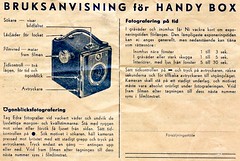
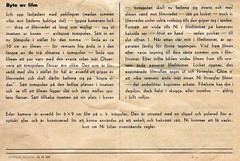
The Handy Box manual. All two pages of it. When the Handy Box aims for simplicity it's not kidding around. How many pages does your typical digital camera manual have? Left of page one describes "instant" photography, and the right side describes "time". The table reads: "Indoors near windows, 1-3 seconds; in gray weather or in shadow, 1-5 seconds; Indoors with window light, 5-30 seconds". Page two describes how to load and unload film.
A big thank you to Per-Anders Westman who kindly scanned his manual for me and sent me the images. It's people like him that make this hobby so rewarding.
A modern camera will try to autofocus for you, but it will take time and it will sometimes focus on the wrong thing or fail to focus at all. Older cameras like the Yashica TLR or Voigtländer Bessa that I've written about need to be focused manually. The Handy Box has a far simpler, more reliable solution: you don't focus the camera at all. The lens is permanently set to a medium distance. It is the ultimate autofocus. If the picture got blurry it's not the camera's fault, you were just not standing in the right place. Selecting the aperture is solved in the same, radically simple way: It is fixed - I measured it to f/16 - and unchangeable. You no longer need to worry about depth of focus issues.
With shutter speed and exposure, too, the Handy Box lives up to its name. Measuring the exposure and setting the right shutter speed is a major worry in modern photography, with whole books devoted to the subject. The Handy Box cuts through this web of complexity: we need no exposure metering since we can't set the shutter speed. The shutter has only two settings: "time" (what we call "bulb" today) and "instant". With the "time" setting, you push the shutter lever one way to open the shutter, and the other way to close it again. At the "instant" setting the shutter will open briefly when you pull the lever, whether up or down. I measured the shutter speed to 1/50 going one way and 1/60 going the other; similar enough to be the same in practice.

The Handy Box viewfinder. It's fairly dim - only useful in daylight, really - and you need to be very precisely positioned to see through it. It's often easier to simply guess your composition.
Fixed focus, fixed aperture, fixed shutter speed - truly, worries about camera settings are a thing of the past with the oh so very handy Handy Box!
What? No settings?
When I first loaded the film and picked up the camera I felt utterly lost. There was no way for me to adjust anything. Our modern cameras give us very precise control; we can adjust every possible setting, and we get instant feedback on everything we do. But while this control is wonderful it is also deceptive; once we can control our settings precisely we soon start to believe that we must do so. We start thinking that a picture that isn't perfectly controlled - perfect focus, perfect exposure, perfect color - is not a good image.
We amateurs and enthusiasts tend to forget that the picture is not the image (professional photographers know this, which is why they spend their time arguing royalty rates and licensing, not pixel-level sharpness). The World Press Photo exhibition passed by Osaka two weeks ago. It honours the best press photography of the year. When you look closely, you realize that a lot of those images are not well controlled; focus, exposure and color may all be off. But a soft or dark image may convey its subject as strongly as a technically perfect one. Many things go into making a good image and technical quality is only one of them.
The most important advice for using an old camera like this is to work with the camera, not fight against it. Use its strengths and embrace its weaknesses. When you have no control over focus or exposure, you don't want to try shooting a wedding album. If your camera is slow to set up and use, don't use it for sports photography. If it's unreliable and erratic, it's no good for scientific imaging ("the camera didn't fire. We have to redo the experiment. All twelve hours of it.").
The Handy Box is not a sharp camera. It has a good amount of distortion, both barrel distortion and vignetting. The images are pretty low contrast and really benefit from a healthy contrast bump in postprocessing. But it is small and light, it's fast (no need to set anything, remember), it's quiet and it is very discreet - people often don't realize it's a camera at all. In other words, it's a really good street camera. Street photography is often in daylight, and the low-fi quality of the images will often complement and enhance the urban motives.
I have another couple of tips for users of older cameras. First, establish a routine. Whenever you have taken a shot, always set the camera back to its standard settings. In my case (as I learned the hard way - see the second picture below) I always wind the film to the next frame and set the shutter to "instant" as soon as I had taken a shot. If you don't make this a habit you will inevitably make a mistake, with interesting consequences. Interesting is good from time to time, of course (I really like that second picture myself), but it's still better to avoid them when you can.
Second, keep a notebook. Your digital camera records all the technical details of your images, but with an older film camera the responsibility is your own. Just make note of the settings you used for each frame so you can go back and compare with the results. And when you're taking notes anyhow it's a good idea to note what you're trying to shoot, and what you're trying to do with the image. It's not easy to remember what you were thinking perhaps weeks after taking it; just a few words jotted down can really help. That helps you improve your composition, not only the technical aspects.
Examples
I shot and developed a roll of Ilford HP5 with this camera last week. The camera is set for sunlit days with the ISO 100 speed films of the time so I figured an ISO 400 film like HP5 should enable me to get decent shots in shadow or when overcast. Sunny days would be too bright so I'd want to avoid that.
The camera really is as easy to use as I say above. When outside, use the "instant" shutter. When inside and it's bright, use something like 1 second (just guesstimate it). In dim light, go to about 3 seconds. If you don't get it exactly, don't worry - black and white film is pretty forgiving, so you'll have a recognizable image even if you're way off on your shutter speed.
Digital photo technology helps us here: since we can easily scan the images and post-process on our computers, exposure problems - and dust, and scratches, and vignetting, and a host of other issues - are much easier to fix today than they were when people printed directly from the negatives. In many ways, these old, manual medium-format cameras are far easier to use than ever before, with the support we can get from digital technology. All the images below have been postprocessed: I removed some dust - not all, just the most obvious specks - adjusted brightness and added some contrast. These are standard tools at our disposal today, we use them for all our other images, and it would be strange not to take advantage of them here as well.
The image quality I get from the Handy Box is pretty even and dependable. Even the images with the most technical issues don't actually look much worse than the technically best ones. When you take a picture with this camera you know what you're going to get. This dependability is part of why it's so amazingly easy to handle: I never measured the light level for any of the images above, and I didn't time the shutter; still, the images turned out good. And with no worries about any technical aspects I had a blast taking them.
I've collected all images related to this camera in its own Flickr set.
Below are the twelve frames from this roll of film, in order.

"Ok, so I'll wind the film to frame 1. And I'm winding and winding, and here's an arrow in the small red window, and another arrow, and some other symbols, and a small horizontal line, and I'm winding and winding, and here's number '2'. '2'?! Agh, was that a '1' before, not a horizontal line? Oh cr*p."
I scanned this without the film holder so I'd get the film markings on the side. Chalk it up as a learning experience.
I scanned this without the film holder so I'd get the film markings on the side. Chalk it up as a learning experience.
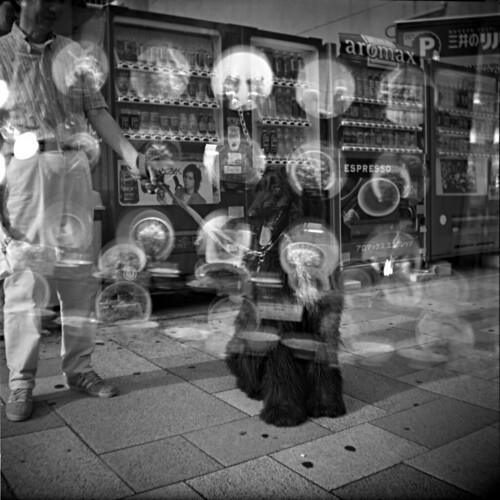
"Ahh, look at that dog! Cute, friendly and thin enough to be almost two-dimensional. The owner looks affable enough. 'Excuse me, could I take a picture?'" The dog owner sees an obviously foreign person brandishing an ancient camera and improbably decides this is a good thing. "'Great! Hold it riiight there. Thank you very much.'"
"It's really hot up on street level; the underground arcade is nice and cool right now. Gotta take a picture of that Ramen restaurant display too. That'll give me an excuse to try longer exposures. Hmm, viewfinder is really hard to see here. Ah, got it. There. Now, wind the film... wind.. the.. film...... Aggh, I forgot to wind it after the dog picture! Poor doggie, and shame about the Ramen."
Easy mistake to avoid, this - make sure you establish a routine as I wrote above. That said, this picture is rather more interesting than either the dog or Ramen display would have been on their own. Almost like a frame from some old Hammer Film horror feature; all it needs is a Vincent Price voice-over.
Composite shot; one taken with "instant" shutter, one at about 1 second.
"It's really hot up on street level; the underground arcade is nice and cool right now. Gotta take a picture of that Ramen restaurant display too. That'll give me an excuse to try longer exposures. Hmm, viewfinder is really hard to see here. Ah, got it. There. Now, wind the film... wind.. the.. film...... Aggh, I forgot to wind it after the dog picture! Poor doggie, and shame about the Ramen."
Easy mistake to avoid, this - make sure you establish a routine as I wrote above. That said, this picture is rather more interesting than either the dog or Ramen display would have been on their own. Almost like a frame from some old Hammer Film horror feature; all it needs is a Vincent Price voice-over.
Composite shot; one taken with "instant" shutter, one at about 1 second.
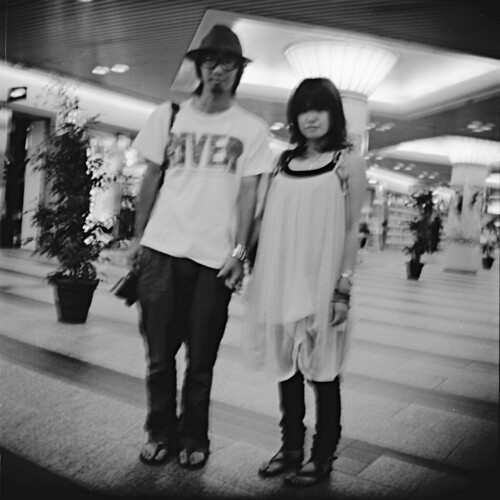
"Oh look, a hip couple, and with camera and all. Low light portrait time! 'Excuse me, could I take your picture?' 'Yes, both of you; you look cool together. There, just stand there so I get the pillar in the back. It'll be a second or so - stand very, very still.' ... 'Got it, thanks!'"
1 second shutter, underexposed. 2-3 seconds would have been better. Of course, that would have gotten me even more motion blur.
1 second shutter, underexposed. 2-3 seconds would have been better. Of course, that would have gotten me even more motion blur.
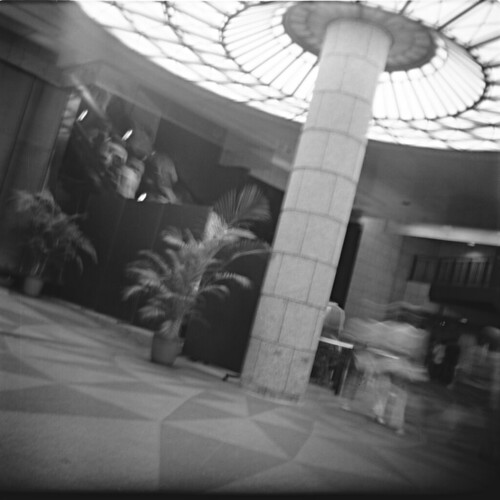
"The high ceiling and those pillars here look cool. Could I get the pillar with that escalator? Worth a try. Get motion blur on the people riding it too."
1 second. The whole image is too blurry for the motion blur idea to work.
1 second. The whole image is too blurry for the motion blur idea to work.
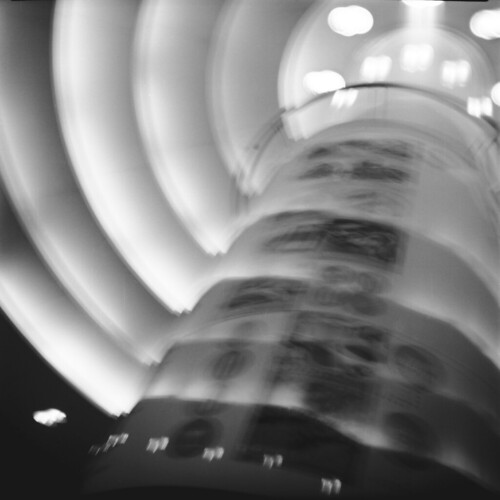
"What if I try to get just the pillar, from below, make it abstract? Try to hold it steady somehow; lean the corner of the camera on the floor I think. Aaand guesstimate the time - umm, the light is pretty bright so a bit less than the other shots should be OK."
About 0.5-0.8 seconds or so. My favourite image.
About 0.5-0.8 seconds or so. My favourite image.
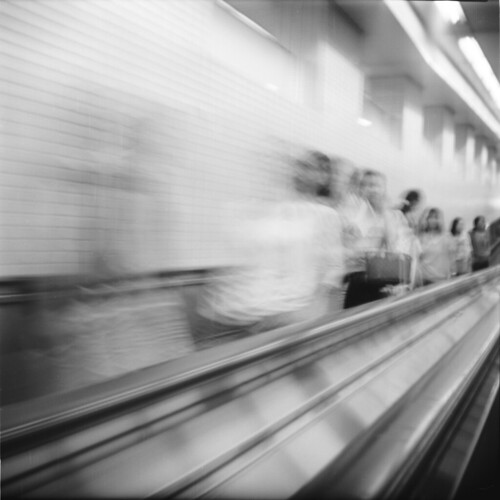
"I don't get the point of this horizontal escalator. I mean, the whole arcade is about a kilometer, and this power walkway runs for all of fifty meters. Sure is fun though. Hey, what if I put the camera on the railing and shoot the people gliding by? Worth a shot."
Around 0.5 seconds.
Around 0.5 seconds.
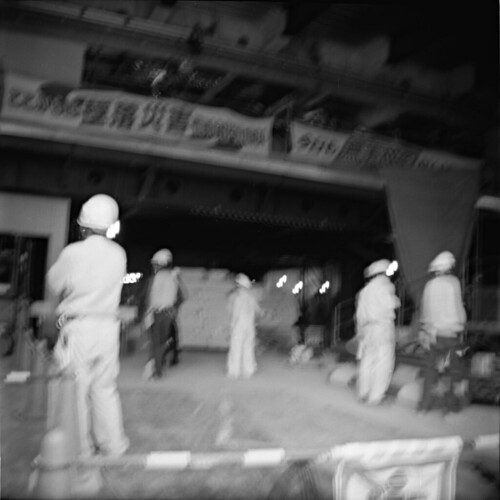
"Construction work. Never fails. Big machinery, exposed frameworks, people in helmets. Pretty dark in there though. Take some extra time perhaps."
2-3 seconds; that overexposed the brightest areas however. And I think the blur is enough to be distracting here.
2-3 seconds; that overexposed the brightest areas however. And I think the blur is enough to be distracting here.
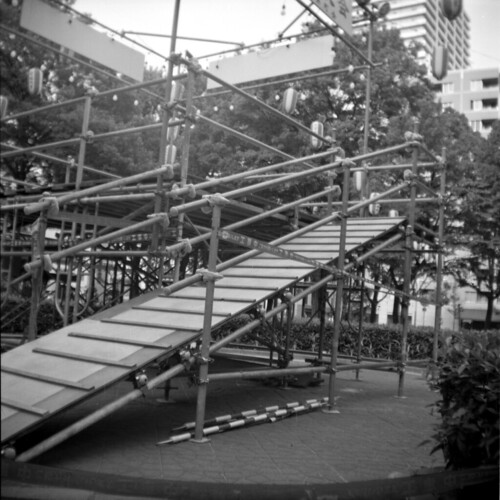
"There's an Obon festival in this park tonight I guess, that's why they've put up the scaffolding and lanterns. Let's see how the camera likes backlight."
"instant" shutter. Backlight is OK; fair bit of veiling glare but nothing distracting.
"instant" shutter. Backlight is OK; fair bit of veiling glare but nothing distracting.
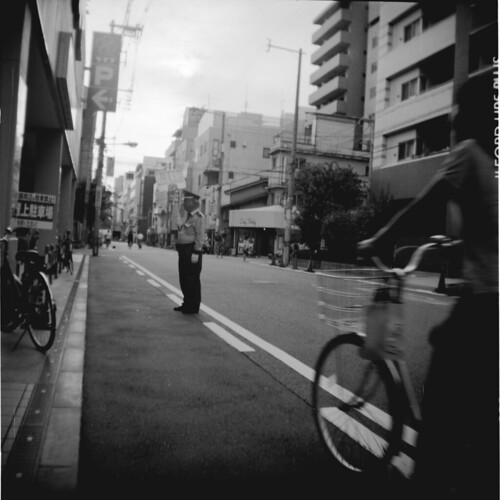
"Nice, deep light - the late afternoon sun is kind of shading the street. If I could just get the guard to look this way... Oh, bicycle coming, got to take it right now."
"instant" shutter. Shadow in late afternoon makes it a bit underexposed.
"instant" shutter. Shadow in late afternoon makes it a bit underexposed.
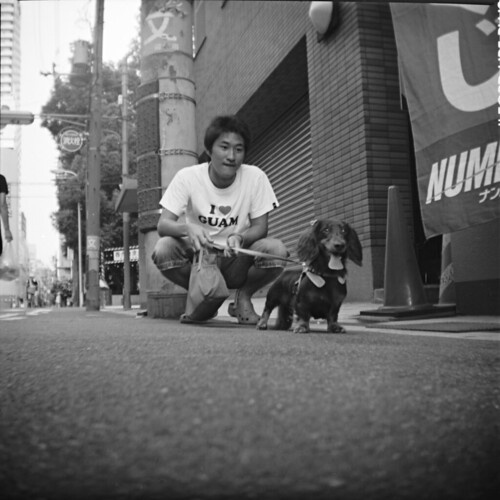
"Another dog! And crouching owner. 'Crouching Owner, Hidden Dachshund' could be a good movie title. Got to get low here. Rule of thumb: Low dog, low picture."
"instant" shutter. Close areas, like the street at the bottom, are very unfocused; the focal plane seems to be at around 4-5 meters.
"instant" shutter. Close areas, like the street at the bottom, are very unfocused; the focal plane seems to be at around 4-5 meters.
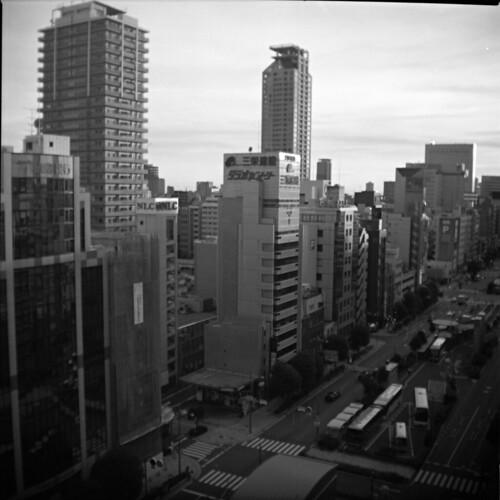
"Evening, and we have a good sunset down Nagahori street. I must have half a dozen images of this already, so I want one for comparison."
"instant" shutter. You can see here that the lens has rather a lot of barrel distortion, with buildings at the edge curving inwards.
"instant" shutter. You can see here that the lens has rather a lot of barrel distortion, with buildings at the edge curving inwards.

"That's some simple, clean geometric light and shadow going on there in the morning light. No way to use the viewfinder so I'll just shoot blind."
"instant" shutter.
"instant" shutter.
EDIT August 2011: Changed links to Per-Anders Westmans current homepage.
---
#1 The name "Göteborgs Kamerafabrik", by the way, means "Gothenburgs Camera Factory" and "Svensk Kameraindustri" means "Swedish Camera Industry", harking back to an era when company names still had a connection to what they were actually doing; do you have any clue what kind of business, say Accentor or Ingenico are in, without clicking through to check?


Great review! I really enjoyed the commentary on the photos - a very good idea.
ReplyDeleteTime is actually different to bulb though. I'm not sure exactly about the origin of the two, but Time (T) more often than not refers to the shutter staying open until another lever is pressed - you mentioned this is the way yours works? - while bulb (B) functions only while the lever is held down. When the pressure is taken off the shutter the exposure ends. However, on my Kodak Six-20 box camera the T labeled setting functions as a B setting, while my Brownie folder has both a T and a B! Somehow I don't think there was a world wide standard :)
Totally support the notebook idea. Often with box cameras it takes a while to shoot the roll, as as you point out, when loaded with 400ISO it's good for only overcast times.
I think my favourite of your shots were the escalator and the second dog. Always wanted to do the escalator thing, and great perspective on the dog.
Thanks!
ReplyDeleteDidn't think of the time/bulb difference, but now that you mention it that's correct of course. "Bulb" is named after that rubber air bulb and hose that was used as remote shutter once upon a time. While the bulb is squeezed the shutter is open. Oh well, I'll leave it as it is for now.
I've started using notebook for my digital images too. Often I have a specific idea in mind for an image, and afterwards I too often forget what that idea was.
By the way, I really enjoyed your entry as well! I don't think I could pull off a simulated dialogue :)
Wow, that brought back some memories. Very, very, vague memories. I think my father had one of those when I was quite young (possibly a leftover from his father), and that I was allowed to use it as a toy. In fact, I mostly remember distinct aspects like the smell and feel of it - the leather strap, the funny lever and the spring action, and the sound it made. I know I never understood at all how it could be a camera - all of the contents had to be missing somehow. It's been so long that I'd all but forgotten that I ever had seen such a thing. The sad remains of it may even still be left in some drawer at my parents'.
ReplyDeleteHi, Richard!
ReplyDeleteDon't give up on that old camera of your parents. They're so very simple and reliable that chances are it still works just fine.
It might be an actual Handy Box, but it's a bit unlikely. It was only made for a couple of years after all, just when more capable camera types were coming down in price as civilian industry got restarted after the war.
I'm not surprised your parents have one, though. I guess many families have one or two in their attics or garages, and a fair number of them probably still work fine. They were made in absolutely huge numbers after all - for instance, in 1930, Kodak celebrated their 50'th birthday by giving away a box camera and film to any child that turned 12 that year.
I'll have to look for it now, the next time I go to visit them. If nothing else, just to see it again with my own eyes.
ReplyDeleteMy father (from Lund) had one of those or vey similar. He developed the films in the kitchen and has a great album full of fun images that capture the spirit of his teenage days.
ReplyDeleteHold on to those boxes, if you have them!
great fun; well done
ReplyDeleteThe moving walkway/escalator image is my fav, followed my the dog with the guy that is wearing the "I (heart) Guam" shirt.
ReplyDeleteExcellent write-up!
Derek, thanks! I like the escalator one too; may have to try a few variations on it sometime.
ReplyDeletebrilliant post
ReplyDelete